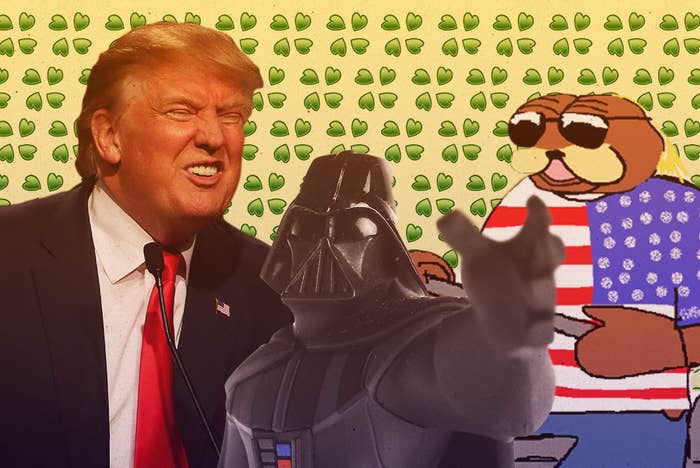
If you were going to draw up a short list of places on the internet that should be excited about the first good Star Wars movie in more than three decades, you would have to include 4chan and 8chan. The infamous, anonymous image boards are nerd culture sanctum sanctorum, places with dauntingly high cultural literacy in science fiction, fantasy, and Japanese animation. You’d imagine posters there would be beside themselves with joy.
Instead, a lot of them just seem pissed off about John Boyega.
Boyega is a black actor with a lead role in Star Wars: The Force Awakens. By all accounts, he turns in a charming and sympathetic performance as Finn, a Stormtrooper with a conscience. But a lot of chan posters don’t seem interested in that. Rather, they’re angry he’s in the movie at all. In the story told through the jokes and jeremiads of dozens of chan posts, Boyega got the job not because of his qualifications as an actor, but because of a nefarious outside force located somewhere between affirmative action and liberal conspiracy, a foreign hand unnaturally pushing cultural diversity into the natural state of pop culture. His presence is seen as an invasion.
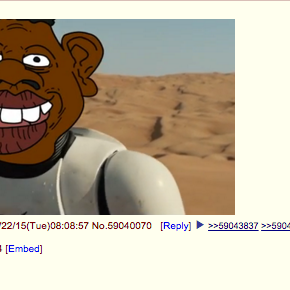
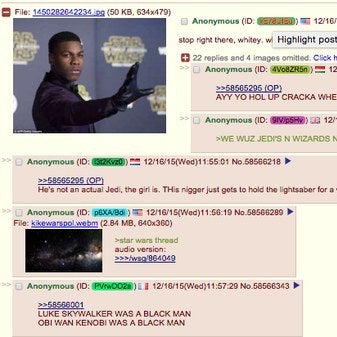
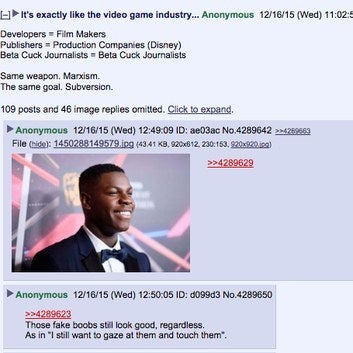
Yet if you're surprised by the reaction to Boyega, you haven't been paying attention.
In 2015 it became clear, obvious even, that various reactionary forces have coalesced into a larger, coherent counterculture — let’s call it the Chanterculture — that exists not just in opposition to racial diversity in politics and culture, but in order to advance its own agenda, which across a variety of fronts seeks to preserve and promote the cultural and political preeminence of white guys. This new movement, and it is a movement, combines age-old racist and sexist rhetoric with bleeding-edge meme culture and technology. It unites two equally irrepressible camps behind an ironclad belief in the duty to say hideous things: the threatened white men of the internet and the "I have no soul" lulzsters.
Perhaps the most obvious example where these things came together was in the rise of #cuckservative — a racist epithet as hashtag, born of online porn, illustrated with memes. But there are plenty of other cases. Chan posters harassing the internet sleuths who discovered Charleston shooter Dylann Roof’s manifesto. 8chan trolls posting to Twitter as “black looters” during the Freddie Gray protests in Baltimore. A legion of horribles chasing Ellen Pao from Reddit for trying to make it marginally less hateful. A shock tactics internet comedy troupe threatening the life of a female game developer for lulz. “Black Hermione.” It goes on.
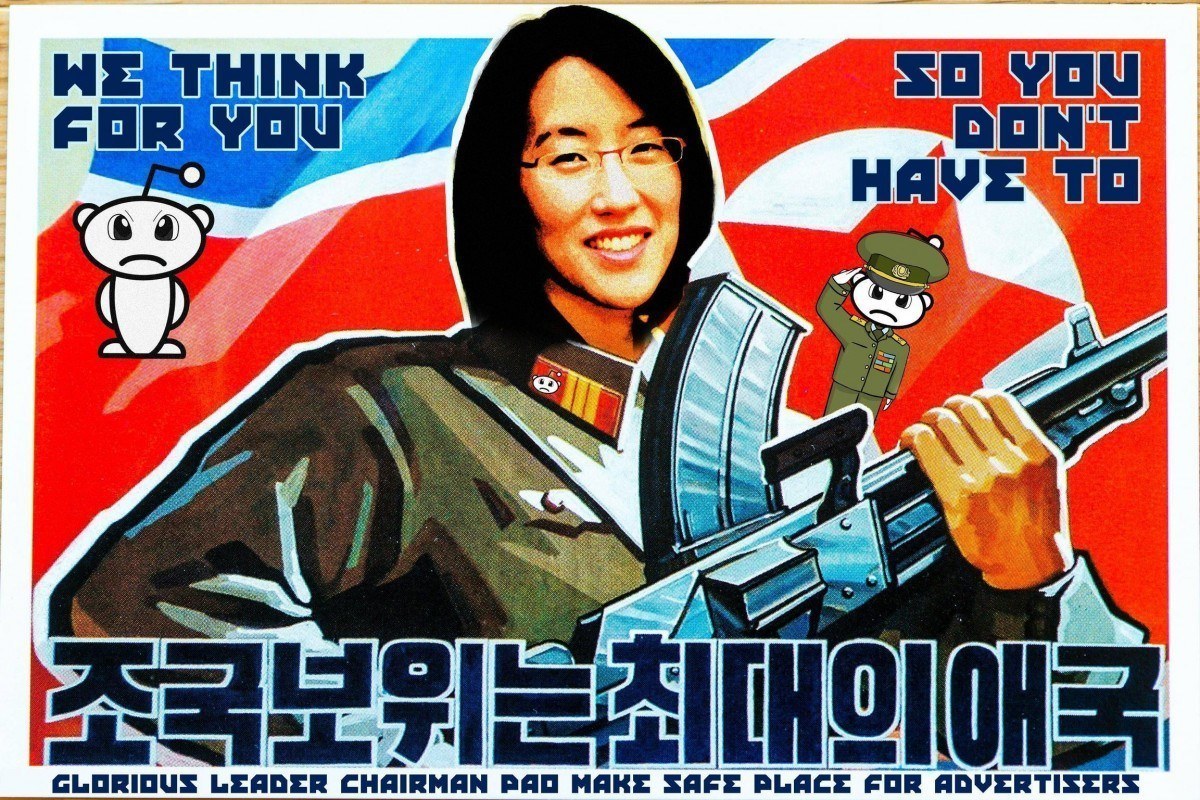
This racist, reactionary, offense-embracing, meme-savvy internet is not simply a disparate collection of ravings from immature and bitter young men with too much time on their hands. Rather it is a flourishing protest culture, indeed a coherent counterculture, created in response to the growing ethnic and gender diversity of contemporary media and pop culture and to the incursion of identity groups into previously homogenous digital spaces. Chanterculture thrives on poorly governed image boards and hard-to-find Blogger sites and free-for-all chat apps. And that is precisely because the major media platforms of our time — Google, Facebook, Twitter, Snapchat, Instagram, Netflix, YouTube — have ushered in this diversity, with original programming featuring people of color and content partnerships with media companies that do the same, as much as with the enforcement of anti-hate-speech Terms of Service.
When we think of countercultures, we typically think of left-leaning ones: hippies, beats, radical punks, even the dreaded hipsters, whatever they were. But as mainstream culture has evolved in the way it treats women, people of color, gay marriage, and the rights of the LGBT community, and as mainstream internet media has gravitated towards identity content, it is not completely surprising that a reactionary culture would arise to oppose it. And like any counterculture, this one has developed its own social norms, accepted truths, sense of humor, methods of communications, and even terminology.
You can see it being built as we speak. Simply navigate to 4chan, or dozens of “politically incorrect” subreddits, and see them reject: Black Lives Matter protests as “#chimpouts,” Jeb Bush for calling immigration “an act of love,” the hated “MSM” for its “social-justice-warrior” reporting on the FDA’s decision to lift the ban on blood donations from gay men, etc., etc., forever. It’s something new every day.
Like any nascent counterculture, Chanterculture produces or adopts heroes who reject the values of what it holds to be the dominant culture. That may be the protagonist of a web comic (about which, more later), or a journalist, like Milo Yiannopoulos, or a politician, like Donald Trump. (This counterculture is equally adept at creating or adopting villains: J.J. Abrams, Barack Obama, Emma Sulkowicz, Brianna Wu, and so on.) It’s telling that both Trump and Yiannopoulos are often described as “characters.” In this culture, they fulfill important roles.
Yiannopoulos, who rode the angry gusts of GamerGate to become the inaugural technology editor of the far-right Breitbart.com, has sensed the potential of the Chanterculture better than anyone. He gives it a champion in the professional media. In an extraordinary November post called “Why I’m Winning,” he attributed his sudden rise in popularity to his willingness to go against the grain of a reflexively liberal internet media in thrall to the chilling forces of political correctness. And then he made a telling appeal to his audience:
“If you have ever felt bullied, or victimised, or harassed, or marginalised – not by bullshit imaginary concepts like the 'patriarchy' but by people who want to stop you expressing yourself and who call you a loser, a manbaby, a shitlord, a privileged cishet white male – then Milo Yiannopoulos is for you.”
Think for a moment about the demographic Yiannopoulos is appealing to as victims: young English-speaking white men, perhaps the least victimized group of people in the world, to whom popular and consumer culture have long catered and who are now angry because they are not doing so quite so much as they were, gosh, a year ago. This kind of reverse victimization politics feels more like the rhetoric you’d hear on the campaign trail (“Milo Yiannopoulos is for you”) than in the tech media. Now it’s everywhere.
So pulses the strange tension at the heart of Chanterculture: It represents and is aligned with the interests of a dominant group, a subset of which has become absolutely convinced it is threatened. It was a tension first revealed by GamerGate, which demonstrated that under the modern internet’s surface layer of samey platforms and feel-good cultural consensus, burbled, in chans and subreddits and forums and anonymous networks and IRC, a reservoir of opposition to its values.
But this year Chanterculture found its true hero, who makes it plain that what we’re seeing is a genuine movement: the current master of American resentment, Donald Trump. Everywhere you look on “politically incorrect” subforums and random chans, he looms. Beneath literally every page on 8chan lurks Trump’s face, which, as Elspeth Reeve put it wonderfully, is “very good to look at.” It is the avatar of Chanterculture. A feverish industry of meme-making has grown up around its contours. It has even, at times, subsumed Pepe.
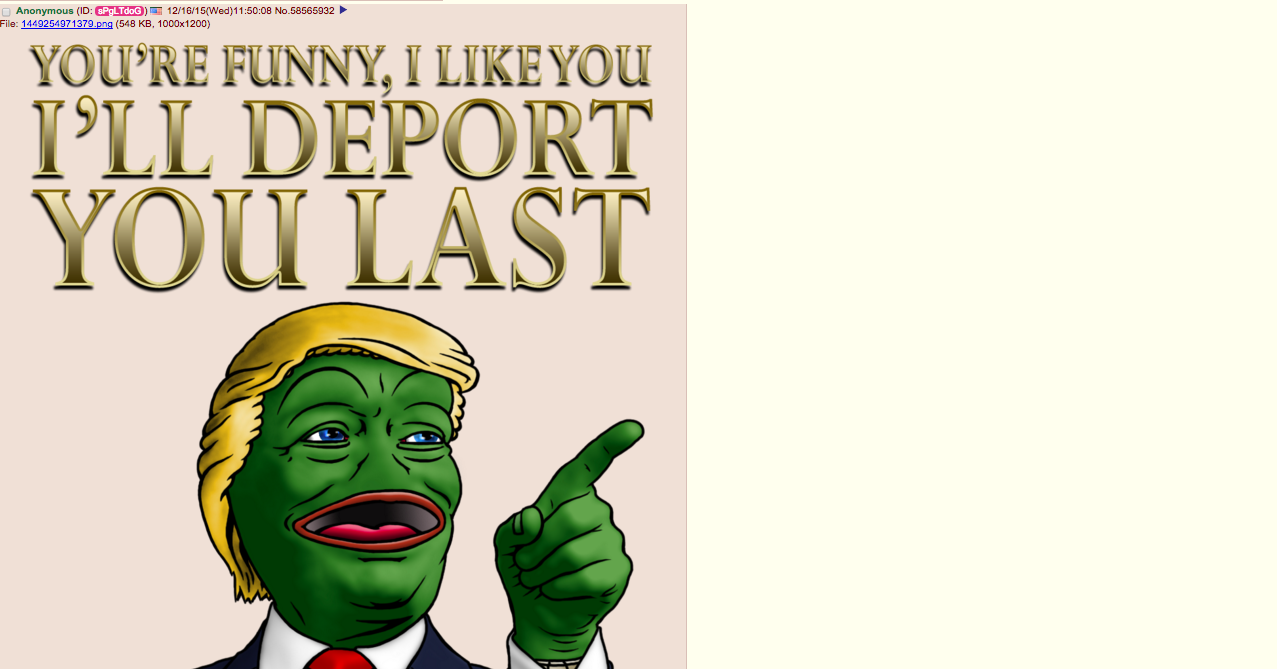
Trump performs for the Chanterculture a very similar function to the one he does for his political supporters: giving loud public voice to culturally unsafe (racist, xenophobic, hateful, choose your adjective) sentiments. He serves less as a real politician with policies and strategy than as the protagonist in a counter-narrative of American culture that sees the forces of modern identity-based liberalism on the verge of genuine acceptance and, it fears, domination. The difference on the internet is, Trump doesn’t need to say anything at all — the creators of the new Chanterculture will say it for him.
In a private group called “Can’t Stump Trump” on the mobile chat service Kik, you’ll find teenagers — between trading weightlifting tips, preferences in female body type, and racist memes — heaping praise on the frontrunner in the Republican presidential race. They claim to support him because he is against “immigration from culturally incompatible ethnic groups,” because “he doesn’t support political correctness,” because “[h]e's not a good candidate for people who care about others, which I don't. No lives matter."
No lives matter! The new counterculture can be, at times, so over the top and so ridiculous that it reads as an elaborate performance. Certainly the sincerity of Yiannopoulos, and the sketch comedians, and Trump, can and should be questioned. And in its own specific way, taken on its own terms, much of this counterculture can be read as satire: morally indignant storytelling that uses exaggeration and humor for shock value to ridicule contemporary culture. So, for example, take the meme-comics starring Le American Bear, the Finnish meme of an obese and easily led American idiot, manipulated by Jews and the media, that has been adopted by the white supremacist internet as a symbol of “blue-pill” white Americans. The Chanterculture, after all, comes in part from the most intensely ironic places on the internet.
Still, for the media platforms through which most of us experience the internet, this kind of speech is bad for business (and shocks the conscience, goes against what we believe in as a society, etc.) whether it is sincere or not. So you end up with a group of people (mostly white, male, young) aligned with dominant interests who feel that their perspective has no place in the increasingly dominant new media, which bills itself as participatory and inclusive. That is how the strange dynamics of victimization come into play.
The logical next step for Chanterculture, so angry with the infiltration of popular culture by others, is to make its own entertainment. (Ironically, this makes it like many of the identity groups to which it objects.) And in its incessant meme-making and conspiracy theorizing about current events, it has already begun to do so.
On a far-flung Blogger, an artist began this year to draw The Adventures of Christ Chan, a manga that tells the story of a young woman warrior and her besieged town, New Bethlehem. In dozens of meme-laden chapters with names like “Holy Steel” and “Hardened Keratin,” Christ Chan battles to keep New Bethlehem free of blacks, gays, atheists, and the fearsome Jew King. Her weapon is a katana; her insignia, the swastika.
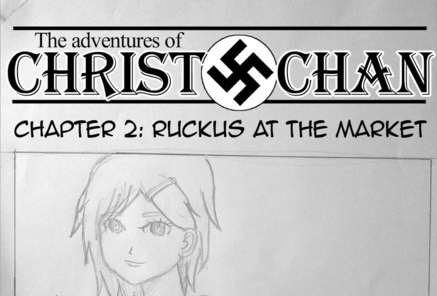
You won’t find it on Facebook or here on BuzzFeed, but The Adventures of Christ Chan is shared daily on the chans.
It’s not quite Star Wars, but it’s a start.
